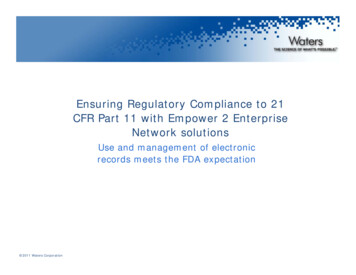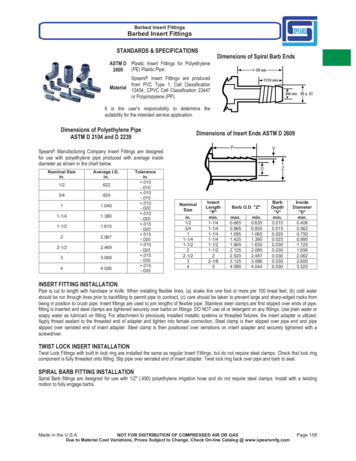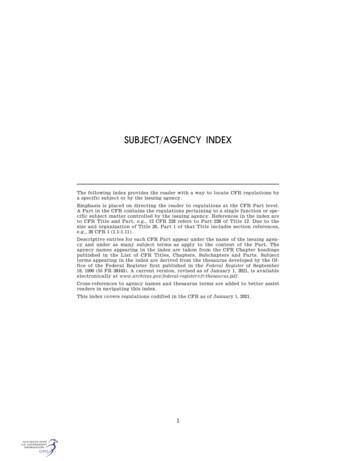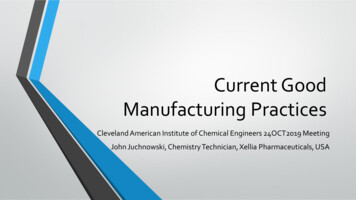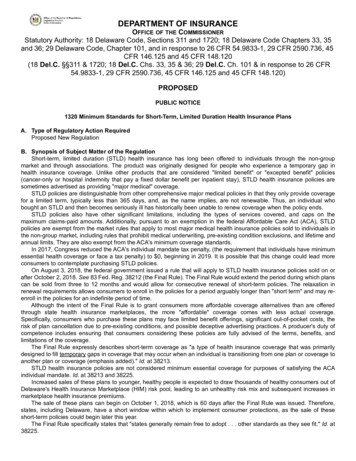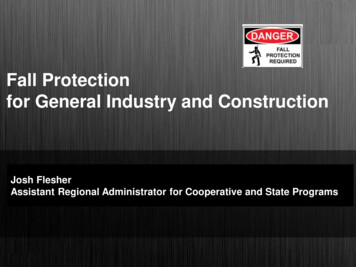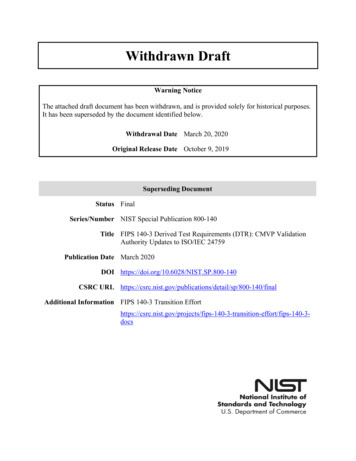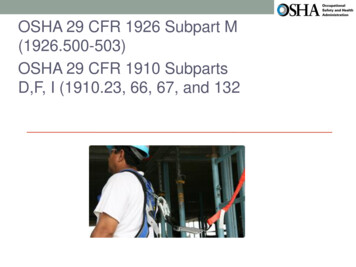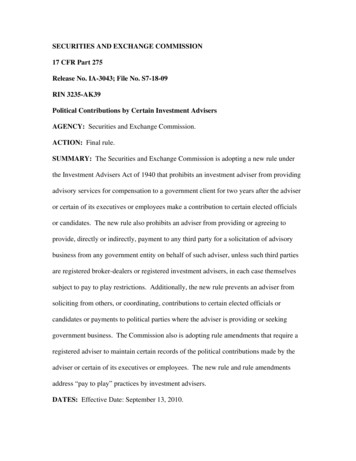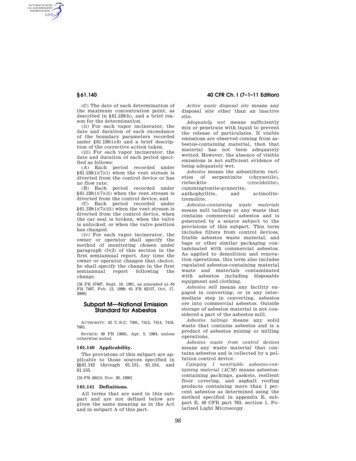
Transcription
§ 61.14040 CFR Ch. I (7–1–11 Edition)Active waste disposal site means anydisposal site other than an inactivesite.Adequately wet means sufficientlymix or penetrate with liquid to preventthe release of particulates. If visibleemissions are observed coming from asbestos-containing material, then thatmaterial has not been adequatelywetted. However, the absence of visibleemissions is not sufficient evidence ofbeing adequately wet.Asbestos means the asbestiform dactinolitetremolite.Asbestos-containing waste materialsmeans mill tailings or any waste thatcontains commercial asbestos and isgenerated by a source subject to theprovisions of this subpart. This termincludes filters from control devices,friable asbestos waste material, andbags or other similar packaging contaminated with commercial asbestos.As applied to demolition and renovation operations, this term also includesregulated asbestos-containing materialwaste and materials contaminatedwith asbestos including disposableequipment and clothing.Asbestos mill means any facility engaged in converting, or in any intermediate step in converting, asbestosore into commercial asbestos. Outsidestorage of asbestos material is not considered a part of the asbestos mill.Asbestos tailings means any solidwaste that contains asbestos and is aproduct of asbestos mining or millingoperations.Asbestos waste from control devicesmeans any waste material that contains asbestos and is collected by a pollution control device.Category I nonfriable asbestos-containing material (ACM) means asbestoscontaining packings, gaskets, resilientfloor covering, and asphalt roofingproducts containing more than 1 percent asbestos as determined using themethod specified in appendix E, subpart E, 40 CFR part 763, section 1, Polarized Light Microscopy.(C) The date of each determination ofthe maximum concentration point, asdescribed in § 61.139(h), and a brief reason for the determination.(ii) For each vapor incinerator, thedate and duration of each exceedanceof the boundary parameters recordedunder § 61.139(i)(6) and a brief description of the corrective action taken.(iii) For each vapor incinerator, thedate and duration of each period specified as follows:(A) Each period recorded under§ 61.139(i)(7)(i) when the vent stream isdiverted from the control device or hasno flow rate;(B) Each period recorded under§ 61.139(i)(7)(ii) when the vent stream isdiverted from the control device; and(C) Each period recorded under§ 61.139(i)(7)(iii) when the vent stream isdiverted from the control device, whenthe car seal is broken, when the valveis unlocked, or when the valve positionhas changed.(iv) For each vapor incinerator, theowner or operator shall specify themethod of monitoring chosen underparagraph (f)(2) of this section in thefirst semiannual report. Any time theowner or operator changes that choice,he shall specify the change in the firstsemiannualreportfollowingthechange.[56 FR 47407, Sept. 19, 1991, as amended at 64FR 7467, Feb. 12, 1999; 65 FR 62157, Oct. 17,2000]Subpart M—National EmissionStandard for AsbestosAUTHORITY: 42 U.S.C. 7401, 7412, 7414, 7416,7601.SOURCE: 49 FR 13661, Apr. 5, 1984, unlessotherwise noted.§ 61.140 Applicability.The provisions of this subpart are applicable to those sources specified in§§ 61.142 through 61.151, 61.154, and61.155.erowe on DSK5CLS3C1PROD with CFR[55 FR 48414, Nov. 20, 1990]§ 61.141 Definitions.All terms that are used in this subpart and are not defined below aregiven the same meaning as in the Actand in subpart A of this part.98VerDate Mar 15 201014:27 Aug 04, 2011Jkt 223151PO 00000Frm 00108Fmt 8010Sfmt 8010Y:\SGML\223151.XXX223151
erowe on DSK5CLS3C1PROD with CFREnvironmental Protection Agency§ 61.141Category II nonfriable ACM means anymaterial, excluding Category I nonfriable ACM, containing more than 1 percent asbestos as determined using themethods specified in appendix E, subpart E, 40 CFR part 763, section 1, Polarized Light Microscopy that, whendry, cannot be crumbled, pulverized, orreduced to powder by hand pressure.Commercial asbestos means any material containing asbestos that is extracted from ore and has value becauseof its asbestos content.Cutting means to penetrate with asharp-edged instrument and includessawing, but does not include shearing,slicing, or punching.Demolition means the wrecking ortaking out of any load-supportingstructural member of a facility together with any related handling operations or the intentional burning ofany facility.Emergency renovation operation meansa renovation operation that was notplanned but results from a sudden, unexpected event that, if not immediately attended to, presents a safetyor public health hazard, is necessary toprotect equipment from damage, or isnecessary to avoid imposing an unreasonable financial burden. This term includes operations necessitated by nonroutine failures of equipment.Fabricating means any processing(e.g., cutting, sawing, drilling) of amanufactured product that containscommercial asbestos, with the exception of processing at temporary sites(field fabricating) for the constructionor restoration of facilities. In the caseof friction products, fabricating includes bonding, debonding, grinding,sawing, drilling, or other similar operations performed as part of fabricating.Facility means any institutional,commercial, public, industrial, or residential structure, installation, orbuilding (including any structure, installation, or building containing condominiums or individual dwelling unitsoperated as a residential cooperative,but excluding residential buildingshaving four or fewer dwelling units);any ship; and any active or inactivewaste disposal site. For purposes ofthis definition, any building, structure,or installation that contains a loftused as a dwelling is not considered aresidential structure, installation, orbuilding. Any structure, installation orbuilding that was previously subject tothis subpart is not excluded, regardlessof its current use or function.Facility component means any part ofa facility including equipment.Friable asbestos material means anymaterial containing more than 1 percent asbestos as determined using themethod specified in appendix E, subpart E, 40 CFR part 763, section 1, Polarized Light Microscopy, that, whendry, can be crumbled, pulverized, or reduced to powder by hand pressure. Ifthe asbestos content is less than 10 percent as determined by a method otherthan point counting by polarized lightmicroscopy (PLM), verify the asbestoscontent by point counting using PLM.Fugitive source means any source ofemissions not controlled by an air pollution control device.Glove bag means a sealed compartment with attached inner gloves usedfor the handling of asbestos-containingmaterials. Properly installed and used,glove bags provide a small work areaenclosure typically used for small-scaleasbestos stripping operations. Information on glove-bag installation, equipment and supplies, and work practicesis contained in the Occupational Safetyand Health Administration’s (OSHA’s)final rule on occupational exposure toasbestos (appendix G to 29 CFR 1926.58).Grinding means to reduce to powderor small fragments and includes mechanical chipping or drilling.In poor condition means the binding ofthe material is losing its integrity asindicated by peeling, cracking, orcrumbling of the material.Inactive waste disposal site means anydisposal site or portion of it where additional asbestos-containing waste material has not been deposited withinthe past year.Installation means any building orstructure or any group of buildings orstructures at a single demolition orrenovation site that are under the control of the same owner or operator (orowner or operator under common control).Leak-tight means that solids or liquids cannot escape or spill out. It alsomeans dust-tight.99VerDate Mar 15 201014:27 Aug 04, 2011Jkt 223151PO 00000Frm 00109Fmt 8010Sfmt 8010Y:\SGML\223151.XXX223151
erowe on DSK5CLS3C1PROD with CFR§ 61.14140 CFR Ch. I (7–1–11 Edition)Malfunction means any sudden andunavoidable failure of air pollutioncontrol equipment or process equipment or of a process to operate in anormal or usual manner so that emissions of asbestos are increased. Failures of equipment shall not be considered malfunctions if they are caused inany way by poor maintenance, carelessoperation, or any other preventableupset conditions, equipment breakdown, or process failure.Manufacturing means the combiningof commercial asbestos—or, in the caseof woven friction products, the combining of textiles containing commercial asbestos—with any other material(s), including commercial asbestos,and the processing of this combinationinto a product. Chlorine production isconsidered a part of manufacturing.Natural barrier means a natural object that effectively precludes or detersaccess. Natural barriers include physical obstacles such as cliffs, lakes orother large bodies of water, deep andwide ravines, and mountains. Remoteness by itself is not a natural barrier.Nonfriable asbestos-containing materialmeans any material containing morethan 1 percent asbestos as determinedusing the method specified in appendixE, subpart E, 40 CFR part 763, section 1,Polarized Light Microscopy, that, whendry, cannot be crumbled, pulverized, orreduced to powder by hand pressure.Nonscheduledrenovationoperationmeans a renovation operation necessitated by the routine failure of equipment, which is expected to occur within a given period based on past operating experience, but for which anexact date cannot be predicted.Outside air means the air outsidebuildings and structures, including, butnot limited to, the air under a bridgeor in an open air ferry dock.Owner or operator of a demolition orrenovation activity means any personwho owns, leases, operates, controls, orsupervises the facility being demolished or renovated or any person whoowns, leases, operates, controls, or supervises the demolition or renovationoperation, or both.Particulate asbestos material meansfinely divided particles of asbestos ormaterial containing asbestos.Planned renovation operations means arenovation operation, or a number ofsuch operations, in which some RACMwill be removed or stripped within agiven period of time and that can bepredicted. Individual nonscheduled operations are included if a number ofsuch operations can be predicted tooccur during a given period of timebased on operating experience.Regulated asbestos-containing material(RACM) means (a) Friable asbestos material, (b) Category I nonfriable ACMthat has become friable, (c) Category Inonfriable ACM that will be or hasbeen subjected to sanding, grinding,cutting, or abrading, or (d) Category IInonfriable ACM that has a high probability of becoming or has becomecrumbled, pulverized, or reduced topowder by the forces expected to act onthe material in the course of demolition or renovation operations regulatedby this subpart.Remove means to take out RACM orfacility components that contain or arecovered with RACM from any facility.Renovation means altering a facilityor one or more facility components inany way, including the stripping or removal of RACM from a facility component. Operations in which load-supportingstructuralmembersarewrecked or taken out are demolitions.Resilient floor covering means asbestos-containing floor tile, including asphalt and vinyl floor tile, and sheetvinyl floor covering containing morethan 1 percent asbestos as determinedusing polarized light microscopy according to the method specified in appendix E, subpart E, 40 CFR part 763,section 1, Polarized Light Microscopy.Roadways means surfaces on whichvehicles travel. This term includespublic and private highways, roads,streets, parking areas, and driveways.Strip means to take off RACM fromany part of a facility or facility components.Structural member means any loadsupporting member of a facility, suchas beams and load supporting walls; orany nonload-supporting member, suchas ceilings and nonload-supportingwalls.Visible emissions means any emissions,which are visually detectable withoutthe aid of instruments, coming from100VerDate Mar 15 201014:27 Aug 04, 2011Jkt 223151PO 00000Frm 00110Fmt 8010Sfmt 8010Y:\SGML\223151.XXX223151
Environmental Protection Agency§ 61.142RACM or asbestos-containing wastematerial, or from any asbestos milling,manufacturing, or fabricating operation. This does not include condensed,uncombined water vapor.Waste generator means any owner oroperator of a source covered by thissubpart whose act or process producesasbestos-containing waste material.Waste shipment record means the shipping document, required to be originated and signed by the waste generator, used to track and substantiatethe disposition of asbestos-containingwaste material.Working day means Monday throughFriday and includes holidays that fallon any of the days Monday throughFriday.[49 FR 13661, Apr. 5, 1984; 49 FR 25453, June 21,1984, as amended by 55 FR 48414, Nov. 20, 1990;56 FR 1669, Jan. 16, 1991; 60 FR 31920, June 19,1995]erowe on DSK5CLS3C1PROD with CFR§ 61.142 Standard for asbestos mills.(a) Each owner or operator of an asbestos mill shall either discharge novisible emissions to the outside airfrom that asbestos mill, including fugitive sources, or use the methods specified by § 61.152 to clean emissions containing particulate asbestos materialbefore they escape to, or are vented to,the outside air.(b) Each owner or operator of an asbestos mill shall meet the following requirements:(1) Monitor each potential source ofasbestos emissions from any part of themill facility, including air cleaning devices, process equipment, and buildingsthat house equipment for materialprocessing and handling, at least onceeach day, during daylight hours, forvisible emissions to the outside air during periods of operation. The monitoring shall be by visual observation ofat least 15 seconds duration per sourceof emissions.(2) Inspect each air cleaning device atleast once each week for proper operation and for changes that signal thepotential for malfunction, including, tothe maximum extent possible withoutdismantling other than opening the device, the presence of tears, holes, andabrasions in filter bags and for dust deposits on the clean side of bags. For aircleaning devices that cannot be inspected on a weekly basis according tothis paragraph, submit to the Administrator, and revise as necessary, a written maintenance plan to include, at aminimum, the following:(i) Maintenance schedule.(ii) Recordkeeping plan.(3) Maintain records of the results ofvisible emissions monitoring and aircleaning device inspections using a format similar to that shown in Figures 1and 2 and include the following:(i) Date and time of each inspection.(ii) Presence or absence of visibleemissions.(iii) Condition of fabric filters, including presence of any tears, holes,and abrasions.(iv) Presence of dust deposits onclean side of fabric filters.(v) Brief description of corrective actions taken, including date and time.(vi) Daily hours of operation for eachair cleaning device.(4) Furnish upon request, and makeavailable at the affected facility duringnormal business hours for inspectionby the Administrator, all records required under this section.(5) Retain a copy of all monitoringand inspection records for at least 2years.(6) Submit semiannually a copy ofvisible emission monitoring records tothe Administrator if visible emissionsoccurred during the report period.Semiannual reports shall be postmarked by the 30th day following theend of the six-month period.101VerDate Mar 15 201014:27 Aug 04, 2011Jkt 223151PO 00000Frm 00111Fmt 8010Sfmt 8010Y:\SGML\223151.XXX223151
40 CFR Ch. I (7–1–11 Edition)102VerDate Mar 15 201014:27 Aug 04, 2011Jkt 223151PO 00000Frm 00112Fmt 8010Sfmt 8006Y:\SGML\223151.XXX223151EC01MY92.000 /GPH erowe on DSK5CLS3C1PROD with CFR§ 61.142
Environmental Protection Agency§ 61.143[55 FR 48416, Nov. 20, 1990, as amended at 64 FR 7467, Feb. 12, 1999]Standard for roadways.No person may construct or maintaina roadway with asbestos tailings or asbestos-containing waste material onthat roadway, unless, for asbestostailings.(a) It is a temporary roadway on anarea of asbestos ore deposits (asbestosmine): or(b) It is a temporary roadway at anactive asbestos mill site and is encapsulated with a resinous or bituminous103VerDate Mar 15 201014:27 Aug 04, 2011Jkt 223151PO 00000Frm 00113Fmt 8010Sfmt 8010Y:\SGML\223151.XXX223151EC01MY92.001 /GPH erowe on DSK5CLS3C1PROD with CFR§ 61.143
§ 61.14440 CFR Ch. I (7–1–11 Edition)binder. The encapsulated road surfacemust be maintained at a minimum frequency of once per year to prevent dustemissions; or(c) It is encapsulated in asphalt concrete meeting the specifications contained in section 401 of Standard Specifications for Construction of Roads andBridges on Federal Highway Projects,FP–85, 1985, or their equivalent.erowe on DSK5CLS3C1PROD with CFR[55 FR 48419, Nov. 20, 1990; 56 FR 1669, Jan. 16,1991]§ 61.144 Standard for manufacturing.(a) Applicability. This section appliesto the following manufacturing operations using commercial asbestos.(1) The manufacture of cloth, cord,wicks, tubing, tape, twine, rope,thread, yarn, roving, lap, or other textile materials.(2) The manufacture of cement products.(3) The manufacture of fireproofingand insulating materials.(4) The manufacture of friction products.(5) The manufacture of paper, millboard, and felt.(6) The manufacture of floor tile.(7) The manufacture of paints, coatings, caulks, adhesives, and sealants.(8) The manufacture of plastics andrubber materials.(9) The manufacture of chlorine utilizing asbestos diaphragm technology.(10) The manufacture of shotgun shellwads.(11) The manufacture of asphalt concrete.(b) Standard. Each owner or operatorof any of the manufacturing operationsto which this section applies shall either:(1) Discharge no visible emissions tothe outside air from these operationsor from any building or structure inwhich they are conducted or from anyother fugitive sources; or(2) Use the methods specified by§ 61.152 to clean emissions from theseoperations containing particulate asbestos material before they escape to,or are vented to, the outside air.(3) Monitor each potential source ofasbestos emissions from any part of themanufacturing facility, including aircleaning devices, process equipment,and buildings housing material proc-essing and handling equipment, atleast once each day during daylighthours for visible emissions to the outside air during periods of operation.The monitoring shall be by visual observation of at least 15 seconds duration per source of emissions.(4) Inspect each air cleaning device atleast once each week for proper operation and for changes that signal thepotential for malfunctions, including,to the maximum extent possible without dismantling other than opening thedevice, the presence of tears, holes, andabrasions in filter bags and for dust deposits on the clean side of bags. For aircleaning devices that cannot be inspected on a weekly basis according tothis paragraph, submit to the Administrator, and revise as necessary, a written maintenance plan to include, at aminimum, the following:(i) Maintenance schedule.(ii) Recordkeeping plan.(5) Maintain records of the results ofvisible emission monitoring and aircleaning device inspections using a format similar to that shown in Figures 1and 2 and include the following.(i) Date and time of each inspection.(ii) Presence or absence of visibleemissions.(iii) Condition of fabric filters, including presence of any tears, holesand abrasions.(iv) Presence of dust deposits onclean side of fabric filters.(v) Brief description of corrective actions taken, including date and time.(vi) Daily hours of operation for eachair cleaning device.(6) Furnish upon request, and makeavailable at the affected facility duringnormal business hours for inspectionby the Administrator, all records required under this section.(7) Retain a copy of all monitoringand inspection records for at least 2years.(8) Submit semiannually a copy ofthevisibleemissionmonitoringrecords to the Administrator if visibleemission occurred during the report period. Semiannual reports shall be postmarked by the 30th day following theend of the six-month period.[49 FR 13661, Apr. 5, 1984, as amended at 55FR 48419, Nov. 20, 1990; 56 FR 1669, Jan. 16,1991; 64 FR 7467, Feb. 12, 1999]104VerDate Mar 15 201014:27 Aug 04, 2011Jkt 223151PO 00000Frm 00114Fmt 8010Sfmt 8010Y:\SGML\223151.XXX223151
erowe on DSK5CLS3C1PROD with CFREnvironmental Protection Agency§ 61.145§ 61.145 Standard for demolition andrenovation.(a) Applicability. To determine whichrequirements of paragraphs (a), (b), and(c) of this section apply to the owner oroperator of a demolition or renovationactivity and prior to the commencement of the demolition or renovation,thoroughly inspect the affected facilityor part of the facility where the demolition or renovation operation willoccur for the presence of asbestos, including Category I and Category IInonfriable ACM. The requirements ofparagraphs (b) and (c) of this sectionapply to each owner or operator of ademolition or renovation activity, including the removal of RACM as follows:(1) In a facility being demolished, allthe requirements of paragraphs (b) and(c) of this section apply, except as provided in paragraph (a)(3) of this section, if the combined amount of RACMis(i) At least 80 linear meters (260 linear feet) on pipes or at least 15 squaremeters (160 square feet) on other facility components, or(ii) At least 1 cubic meter (35 cubicfeet) off facility components where thelength or area could not be measuredpreviously.(2) In a facility being demolished,only the notification requirements ofparagraphs (b)(1), (2), (3)(i) and (iv), and(4)(i) through (vii) and (4)(ix) and (xvi)of this section apply, if the combinedamount of RACM is(i) Less than 80 linear meters (260 linear feet) on pipes and less than 15square meters (160 square feet) on otherfacility components, and(ii) Less than one cubic meter (35cubic feet) off facility componentswhere the length or area could not bemeasured previously or there is no asbestos.(3) If the facility is being demolishedunder an order of a State or local government agency, issued because the facility is structurally unsound and indanger of imminent collapse, only therequirements of paragraphs )), (b)(5), and (c)(4) through(c)(9) of this section apply.(4) In a facility being renovated, including any individual nonscheduledrenovation operation, all the requirements of paragraphs (b) and (c) of thissection apply if the combined amountof RACM to be stripped, removed, dislodged, cut, drilled, or similarly disturbed is(i) At least 80 linear meters (260 linear feet) on pipes or at least 15 squaremeters (160 square feet) on other facility components, or(ii) At least 1 cubic meter (35 cubicfeet) off facility components where thelength or area could not be measuredpreviously.(iii) To determine whether paragraph(a)(4) of this section applies to plannedrenovation operations involving individual nonscheduled operations, predict the combined additive amount ofRACM to be removed or stripped during a calendar year of January 1through December 31.(iv) To determine whether paragraph(a)(4) of this section applies to emergency renovation operations, estimatethe combined amount of RACM to beremoved or stripped as a result of thesudden, unexpected event that necessitated the renovation.(5) Owners or operators of demolitionand renovation operations are exemptfrom the requirements of §§ 61.05(a),61.07, and 61.09.(b) Notification requirements. Eachowner or operator of a demolition orrenovation activity to which this section applies shall:(1) Provide the Administrator withwritten notice of intention to demolishor renovate. Delivery of the notice byU.S. Postal Service, commercial delivery service, or hand delivery is acceptable.(2) Update notice, as necessary, including when the amount of asbestosaffected changes by at least 20 percent.(3) Postmark or deliver the notice asfollows:(i) At least 10 working days before asbestos stripping or removal work orany other activity begins (such as sitepreparation that would break up, dislodge or similarly disturb asbestos material), if the operation is described inparagraphs (a) (1) and (4) (except(a)(4)(iii) and (a)(4)(iv)) of this section.If the operation is as described in paragraph (a)(2) of this section, notification105VerDate Mar 15 201014:27 Aug 04, 2011Jkt 223151PO 00000Frm 00115Fmt 8010Sfmt 8010Y:\SGML\223151.XXX223151
erowe on DSK5CLS3C1PROD with CFR§ 61.14540 CFR Ch. I (7–1–11 Edition)is required 10 working days before demolition begins.(ii) At least 10 working days beforethe end of the calendar year precedingthe year for which notice is being givenfor renovations described in paragraph(a)(4)(iii) of this section.(iii) As early as possible before, butnot later than, the following workingday if the operation is a demolition ordered according to paragraph (a)(3) ofthis section or, if the operation is arenovation described in paragraph(a)(4)(iv) of this section.(iv) For asbestos stripping or removalwork in a demolition or renovation operation, described in paragraphs (a) (1)and (4) (except (a)(4)(iii) and (a)(4)(iv))of this section, and for a demolition described in paragraph (a)(2) of this section, that will begin on a date otherthan the one contained in the originalnotice, notice of the new start datemust be provided to the Administratoras follows:(A) When the asbestos stripping orremoval operation or demolition operation covered by this paragraph willbegin after the date contained in thenotice,(1) Notify the Administrator of thenew start date by telephone as soon aspossible before the original start date,and(2) Provide the Administrator with awritten notice of the new start date assoon as possible before, and no laterthan, the original start date. Deliveryof the updated notice by the U.S. Postal Service, commercial delivery service, or hand delivery is acceptable.(B) When the asbestos stripping or removal operation or demolition operation covered by this paragraph willbegin on a date earlier than the original start date,(1) Provide the Administrator with awritten notice of the new start date atleast 10 working days before asbestosstripping or removal work begins.(2) For demolitions covered by paragraph (a)(2) of this section, provide theAdministrator written notice of a newstart date at least 10 working days before commencement of demolition. Delivery of updated notice by U.S. PostalService, commercial delivery service,or hand delivery is acceptable.(C) In no event shall an operationcovered by this paragraph begin on adate other than the date contained inthe written notice of the new startdate.(4) Include the following in the notice:(i) An indication of whether the notice is the original or a revised notification.(ii) Name, address, and telephonenumber of both the facility owner andoperator and the asbestos removal contractor owner or operator.(iii) Type of operation: demolition orrenovation.(iv) Description of the facility or affected part of the facility including thesize (square meters [square feet] andnumber of floors), age, and present andprior use of the facility.(v) Procedure, including analyticalmethods, employed to detect the presence of RACM and Category I and Category II nonfriable ACM.(vi) Estimate of the approximateamount of RACM to be removed fromthe facility in terms of length of pipein linear meters (linear feet), surfacearea in square meters (square feet) onother facility components, or volumein cubic meters (cubic feet) if off thefacility components. Also, estimate theapproximate amount of Category I andCategory II nonfriable ACM in the affected part of the facility that will notbe removed before demolition.(vii) Location and street address (including building number or name andfloor or room number, if appropriate),city, county, and state, of the facilitybeing demolished or renovated.(viii) Scheduled starting and completion dates of asbestos removal work (orany other activity, such as site preparation that would break up, dislodge,or similarly disturb asbestos material)in a demolition or renovation; plannedrenovation operations involving individual nonscheduled operations shallonly include the beginning and endingdates of the report period as describedin paragraph (a)(4)(iii) of this section.(ix) Scheduled starting and completion dates of demolition or renovation.(x) Description of planned demolitionor renovation work to be performed106VerDate Mar 15 201014:27 Aug 04, 2011Jkt 223151PO 00000Frm 00116Fmt 8010Sfmt 8010Y:\SGML\223151.XXX223151
erowe on DSK5CLS3C1PROD with CFREnvironmental Protection Agency§ 61.145and method(s) to be employed, including demolition or renovation techniques to be used and description of affected facility components.(xi) Description of work practices andengineering controls to be used to comply with the requirements of this subpart, including asbestos removal andwaste-handling emission control procedures.(xii) Name and location of the wastedisposal site where the asbestos-containing waste material will be deposited.(xiii) A certification that at least oneperson trained as required by paragraph (c)(8) of this section will supervise the stripping and removal described by this notification. This requirement shall become effective 1year after promulgation of this regulation.(xiv) For facilities described in paragraph (a)(3) of this section, the name,title, and authority of the State orlocal government representative whohas ordered the demolition, the datethat the order was issued, and the dateon which the demolition was ordered tobegin. A copy of the order shall be attached to the notificati
emissions not controlled by an air pol-lution control device. Glove bag means a sealed compart-ment with attached inner gloves used for the handling of asbestos-containing materials. Properly installed and used, glove bags provide a small work area enclosure typically used for small-scale asbestos stripping operations. Informa-
